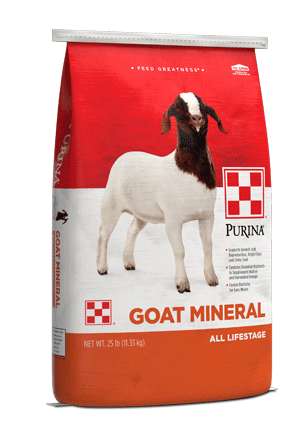
Selecting and Raising Replacement Does
Wellness : Nutrition

What’s the best way to establish a return on investment from your goat operation? Start with strong, healthy replacement does.
But choosing and developing the right replacement females isn’t an easy task – there are a lot of factors to consider that could impact the future productivity of your herd.
Set your herd up for long-term success with this advice for selecting and raising replacements:
Consider these factors when selecting your replacements:
You want to provide enough energy and protein to keep them growing without getting over-conditioned. Feed a high-fiber, 16% protein diet to support kid growth, maintain efficient feed conversion and body condition and avoid developing fat in the udders. Purina® Goat Grower 16 Plus Up DQ.0015 is a good option with highly palatable pellets and balanced proteins, vitamins, minerals and other nutrients.
And, offer free-choice Purina® Goat Mineral, designed to support skeletal growth in replacement doelings.
For doelings, timelines are much shorter. Ideally, doelings would receive a few months on a replacement feeding program before moving back out to pasture to get bred at around 6-7 months of age. For those keeping doelings on pasture at all times, provide additional supplementation a few times a day to prepare them for carrying kids.
Body condition and overall size should be considered when identifying when doelings are ready for breeding. If animals lack maturity, they won’t cycle, and breeding may be delayed. Replacement doelings should be 40% of their mature body weight at breeding.
Want more goat nutrition tips? Sign up for our e-tips program.
But choosing and developing the right replacement females isn’t an easy task – there are a lot of factors to consider that could impact the future productivity of your herd.
Set your herd up for long-term success with this advice for selecting and raising replacements:
Choosing the right replacements
Most operations begin selecting replacements at weaning. Weaning times may be different for different herds, but keep in mind that the more time you give animals to develop, the easier it will be to spot a good replacement.Consider these factors when selecting your replacements:
- Doe and buck’s pedigree and history
- Overall health and condition
- Easy-keeping animals
- Body structure (level top, level dock, sound mouth, correct set of feet and legs)
- Teat quality
- Weaning weights
Feeding replacement doelings
If you’re going to invest money in supplemental nutrition for one area of your herd, we recommend focusing on replacements – they are the future of your herd. Following weaning, separate replacements from those going to market and implement a replacement feeding program designed to develop them into ideal breeding stock.You want to provide enough energy and protein to keep them growing without getting over-conditioned. Feed a high-fiber, 16% protein diet to support kid growth, maintain efficient feed conversion and body condition and avoid developing fat in the udders. Purina® Goat Grower 16 Plus Up DQ.0015 is a good option with highly palatable pellets and balanced proteins, vitamins, minerals and other nutrients.
And, offer free-choice Purina® Goat Mineral, designed to support skeletal growth in replacement doelings.
Preparing for breeding
Yearlings are often kept on a replacement feeding program until about ten months of age before turning back out to pasture and bred at around a year or year and a half. These animals are more accustomed to forage conditions, have reached nearly their mature size and are easier to breed. Continue offering free-choice mineral while on pasture to prepare animals for breeding.For doelings, timelines are much shorter. Ideally, doelings would receive a few months on a replacement feeding program before moving back out to pasture to get bred at around 6-7 months of age. For those keeping doelings on pasture at all times, provide additional supplementation a few times a day to prepare them for carrying kids.
Body condition and overall size should be considered when identifying when doelings are ready for breeding. If animals lack maturity, they won’t cycle, and breeding may be delayed. Replacement doelings should be 40% of their mature body weight at breeding.
Management basics
Replacement does are set up to perform when implementing proper management practices. Remember the following when developing replacements:- Follow a herd health plan under the guidance of a veterinarian. Adhere to label requirements for the proper timing of vaccinations and dewormers.
- Cover the basics, like trimming hooves and providing shelter against the heat and other inclement weather conditions.
- Keep a close eye on the herd and be ready to intervene if they show any signs of common diseases.
- If purchasing replacements, make sure you know the health and management history. Quarantine new herd members for a minimum 7 days to avoid spreading disease.
Want more goat nutrition tips? Sign up for our e-tips program.


.png?width=300&height=430&ext=.png)
